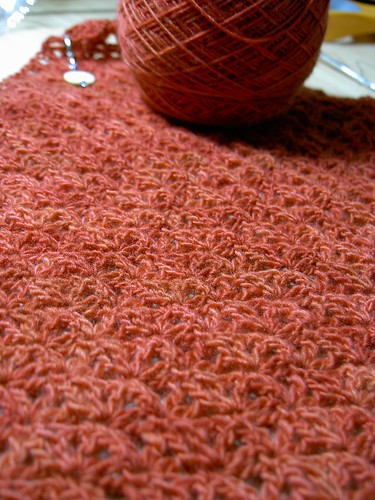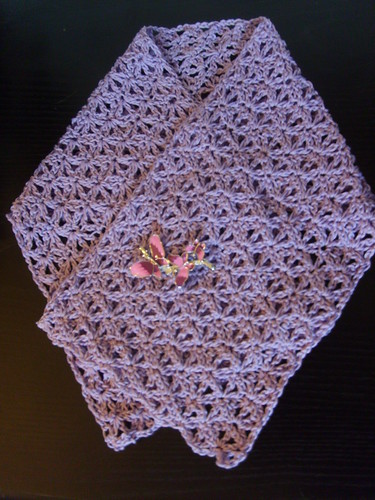A few things have been happening around the Internets that got me thinking again about fair use. It’s one of my favorite perennial topics. I am passionate about the idea that artists, crafters, makers, writers and other creators can take inspiration and even content from other works of art. It’s a concept that can be misunderstood. Some people perceive it too liberally, others don’t believe that aspects of fair use are possible even if they are ethical and legal. Here are a couple of real-life examples.
The other day I was looking through projects on Ravelry. It’s such a treat to see when people make one of my patterns. I love seeing all the yarn choices and variations.

One of my most popular patterns is the Alpine Frost Scarf. (The beautiful photos in this post are all pictures of the design that I found on Flickr, they are not from the crocheter I discuss below.) There are a lot of ways people can get this pattern. It was originally published in Interweave Crochet, in Winter 2008. So if you have that issue in print or digital versions, you have it. You can buy the pattern individually from the Interweave Store. It’s even included in the new book, The Best of Interweave Crochet .
.

So, I was surprised when I was trolling the hundreds of Ravelry projects for this pattern the other day and I stumbled upon one where the crocheter said something like, “I didn’t have the pattern for this design, so this is my version.” Then, she proceeded to show the instructions for her version in the pattern notes on her project page.
Guess what? I’m not bothered that she reverse-engineered my pattern. More power to her! I applaud the ingenuity it takes to figure something out on your own. I’m not even bothered that she wrote down her notes. I am concerned that she thinks it’s ok to essentially publish those notes for anyone on Ravelry to use, and associate her publication with my pattern.

In my opinion, it’s totally ok to reverse-engineer, and even design and publish patterns inspired by the work of others. I’m a big believer in supporting derivative work. It should be derivative though, not just a copy. Publishing a simple copy seems uninspired and not respectful of the original designer’s intellectual property. What didn’t make sense was the fact that this crocheter used my pattern page to post her own version of the pattern.
So, I e-mailed her. Good news! She answered quickly, and removed the instructions from her notes. A happy ending. I wonder what she thought of my e-mail, she didn’t say. The long and short of it? I hope when people exercise fair use and publish the results that they’ll be polite, they won’t violate copyright, and they’ll use appropriate attribution–giving credit where credit is due. Also, I want people to experiment, be creative, have fun.
Today, I was trolling again and found a beautiful scarf that people have been making lots of, apparently. Since this pattern isn’t published in English, people have been sharing scanned versions of the (Japanese?) (Chinese?) chart on Ravelry. What’s the ethical crafter to do if she wants to make something like this scarf? Well, I would like to see her try and reverse engineer the scarf herself, and then come up with her own pattern–hopefully adding her own originality and spin to the design.
Finally, I wanted to mention one other great conversation about fair use happening right now (not surprisingly) on Kim Werker’s blog. (Kim and I worked together to try and launch Fair Use in Art and Craft Day back in 2009–maybe I’ll nudge her and see if we can get it going again for 2012.) Kim’s discussion is about Pintrest — a site where people keep track of things they think are cool on the internet. At issue is the idea that crafters are copying ideas from pictures instead of buying what’s being offered for sale. I’m with Kim on this one–I think that people selling crafts that are simple enough to copy from a photo shouldn’t be surprised when people do so.
Before I started working as a publishing designer, I sold fancy crocheted scarves at craft fairs for around $100 each (this barely covered my costs, so I didn’t do it for long). There were two types of people visiting the craft fairs–customers and crafters. Customers were happy to pay for my hand-work. Crafters were sometimes polite and engaging, but sometimes they’d just say things like, “Oh, I could just make this myself.” It can be annoying when you’re trying to pay the bills, but that doesn’t make it less true. Now that I’m a designer and teacher I don’t want control of my designs after I publish them–I want to see how people get creative with them. I’m happy to be in the position of saying, “Yes! Go make it yourself!”



























